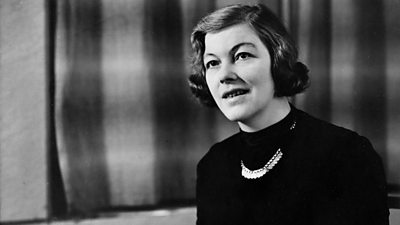From the very beginning in 1922, the ����ý was necessarily experimental. Grappling with the new medium of radio, limited resources, staff and experience, it tried different broadcasting styles and formats in order to find out what was possible and what worked.
And in that tension between the evolving technical properties of broadcasting and the creative imaginations of a small band of pioneers, the principles of British public service broadcasting emerged: to inform, educate and entertain. Not as distinct and separate elements, but as a compound mixture, each reliant on the others.
Children’s Hour
It was in this atmosphere of initial experimentation that programmes for children first entered the schedules. In an interview from the ����ý Oral History Collection one of the founding executives of the ����ý, and World War One flying ace, Cecil Lewis, explained the haphazard and impromptu way in which children’s programmes began.
The intimacy of the microphone, as Lewis put it, was magnified by the local flavour of a lot of the ����ý’s early output. With an initial broadcasting range of around 25 miles, it was a few years before there were sufficient radio stations and transmitters to provide a national service.
This meant that Children’s Hour, along with other programmes, evolved as part of local broadcasting systems: devised, performed and beamed out from regional centres. As a consequence, there were multiple Children’s Hours throughout the country, each with a distinctive broadcast tone and identity.
Manchester became a major centre for the production of children’s programmes and it was here, in 1934, that Olive Shapley arrived to take charge of Children’s Hour for the North Region. Shapley, who would become an influential documentary-maker, as well as presenter and producer of Woman’s Hour, recalled the imaginative environment in which these children’s programmes were made.
The new mass medium of broadcasting allowed programmes such as these to become an accompaniment to the daily lives of children, breeding familiarity not just with the “Aunts” and “Uncles” of Children’s Hour, but with a diverse range of programme styles, from music and drama, to news and competitions. As Shapley points out, they brought a sense of engagement and participation into the increasingly mediated lives of young people.
School Broadcasting
Meanwhile, by 1924 the ����ý had already embarked on a more formal approach to scholastic programming when it started special broadcasts for schools. A talk about music by Sir Henry Walford Davies, Professor of Music at Gresham College, London, was followed by a series of lectures given by eminent scholars on their specialist subjects. But this academic style proved rather challenging and unpopular with those school-children who had the facilities to listen.

In response, School Radio changed direction and addressed curriculum-relatedthemes in a way that was intended to support teachers. From 1929 this was done under the leadership of Mary Somerville, considered by many as “the world pioneer of school broadcasting”.
Somerville’s approach was child-centric, with a focus on engaging, enlivening and enriching the educational experience of young people. And she built a team of broadcasters, including the influential Rhoda Power, who applied the skills and techniques of production – sound effects and the sense of a virtual reality – to illuminate learning through radio.
By the 1930s, and principally transmitted on the new National Programme, schools broadcasting had developed into a major enterprise. And while many of these programmes have evaporated into historical memory others have maintained a resonant cultural significance as an educational rite of passage. As can be heard from this clip of Ann Driver introducing Music and Movement, which bears more than a passing resemblance to the ����ý’s current Primary Dance programmes, eight decades later.
From the beginning of ����ý radio, programmes for children – informative, educational and entertaining – were at the core of its broadcast activities: a founding principle. And as the country went to war in 1939, the reliance on the Corporation as an educator, explainer and companion for young people was further woven into the DNA of British broadcasting.
Television Age
The massive expansion of ����ý output during the Second World War entrenched the idea of public service broadcasting as a force for the common good. Meanwhile, the 1944 Education Act widened educational participation amongst the most disadvantaged and poorest in society. These democratising influences meant that schools broadcasting had, by the end of the war, became an established part of the British education system.
The restart of the ����ý’s Television Service in June 1946 and the establishment of a Children’s Television department saw the creation of iconic programmes such as Muffin the Mule, Watch with Mother, Whirlygig and Flower Pot Men. Meanwhile, television programmes for schools took a little longer to become established.
A pilot scheme was tried in 1952 with a handful of programmes produced at the ����ý’s Alexandra Palace studios transmitted by landline to six local schools. But as the future Controller of Educational Broadcasting at the ����ý Donald Grattan explains, it took another five years, and competition from the recently launched Independent Television (ITV) companies, before the Corporation embarked on a regular television service for schools.
Among those early transmissions, running between Tuesdays and Fridays at 2pm, viewers would have encountered programmes such as ‘Living in the Commonwealth’, ‘Science Helps’, and the current affairs programme, ‘Spotlight’. The last of which did not shy away from challenging topics, as this October 1957 clip on the subject of ‘Blood Sports’, demonstrates.
Over time, ����ý television developed a wide range of curriculum-related programmes for schools,combining a pedagogically-informed approach with the production values and creative vision of programme-makers. But while educational programmes for children had hitherto dominated the ����ý’s thinking, by the 1960s there was growing pressure to address the issue of adult learning.
The Open University
By the time the Labour Party won the 1964 General Election its leader and the Prime Minister, Harold Wilson, had already made a point of advocating a “university of the air”, accessible to all. As it happened, the ����ý’s Controller of Educational Broadcasting, John Scupham, was already devising programmes of this kind in partnership with the Department of Education. These, however, were soon overtaken by plans for a new Open University, in which the ����ý was to play a central role.
Awarded a Royal Charter in April 1969, The Open University quickly became synonymous with a new style of higher educational broadcasting. But as the partnership between the ����ý and the new university was being negotiated a sensitive issue arose around who, ultimately, took responsibility for what was broadcast: university academics, or ����ý producers? In this interview from the ����ý Oral History Collection the first Vice-Chancellor of The Open University, Walter Perry, explains how this thorny problem was resolved.
As with schools broadcasting, the ����ý’s programmes for The Open University were not intended as a replacement for university education. They were there to illustrate subject matter and enrich scholarship. However, the unique structure of distance learning meant that a heavy reliance was placed on radio and television programmes, which acted as the public interface between students and their studies. As a result, these broadcasts have themselves become cultural artefacts that map the evolution of higher education in Britain.
Digital Britain
Radio and television broadcasting provided new ways of doing, understanding, and communicating knowledge. And this is also true of the digital age, where the remapping of our knowledge practices through digital technologies has happened at enormous scale and pace. Within the space of a generation, our mechanisms of learning have radically altered.
But this move online is only the latest development in a surprisingly long history of the ����ý’s engagement with digital education. Responding to the increasing power and influence of computing technologies, by the late 1970s the ����ý began to address concerns about theunpreparedness of British society to manage the impact of the silicon microchip.
The result was the launch of the ����ý’s Computer Literacy Project in 1982. A major programming, publishing and engineering enterprise, it has been credited with inspiring a generation of coders. It also involved the design and manufacture of the ����ý Micro desktop computer, used as part of the British government’s Computers for Schools programme.
Such was the success of the project that its programmes attracted large national audiences. So much so that in 1983 a special live two-hour broadcast of Making the Most of the Micro transmitted on ����ý One, spawning a series of Micro Live transmissions.
The ����ý’s concern with our digital education has continued and there is a direct link between the ����ý Micro agenda of the 1980s and the more recent 2015 launch of the ����ý’s Make It Digital campaign. And in an echo from the past, the ����ý has also produced its own hardware, a pocket-sized computer called the ����ý micro:bit.
The ����ý has now been making educational programmes – informing and entertaining – for a whole century, exploiting the creative relationship between evolving media technologies and learning. In multiple ways, it has schooled the nation from nursery to doctoral study, and all points between. And the founding injunction on the ����ý to educate is both a principle and practice that continues to articulate the purpose of public service broadcasting across the United Kingdom.
Written by Dr. Alban Webb, Lecturer in Media and Cultural Studies, University of Sussex.

